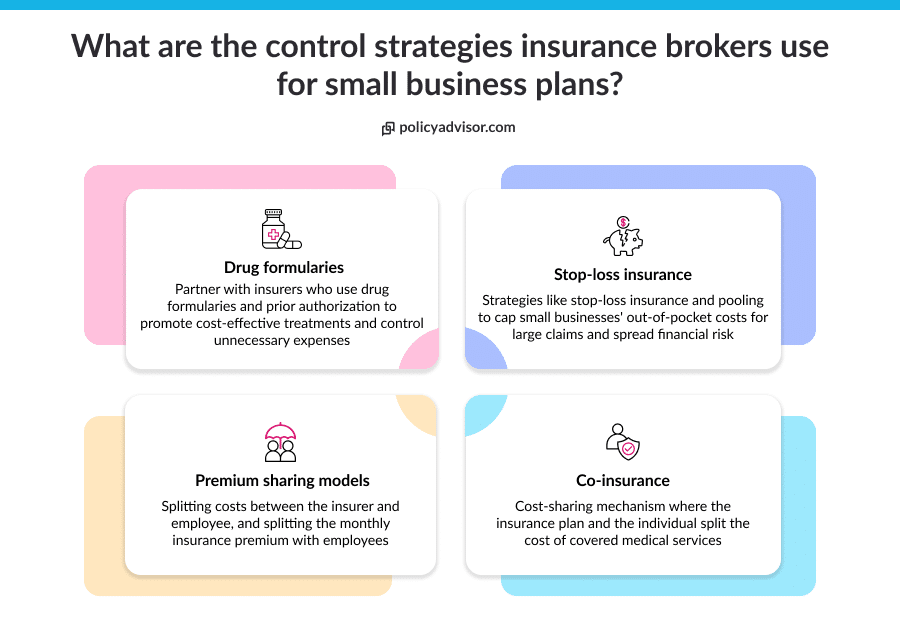Most employers in Canada want the best for their employees. And why shouldn’t they? Having your employees’ backs will mean they’ll have yours too. It is a win-win situation.
So the question is, how can you, as an employer, go the extra mile for your workers? The easiest answer is by offering a group benefit plan. According to a report by CHLIA, almost 90% of health insurance sold in Canada is a part of a group insurance plan.
Employee benefits plans or group plans are a bunch of perks, such as health, dental care, vision care, paramedical and medical services, and life insurance that are offered by employers to their employees. In this blog, we’ve reviewed the top group benefits providers in Canada and have listed their unique offerings.
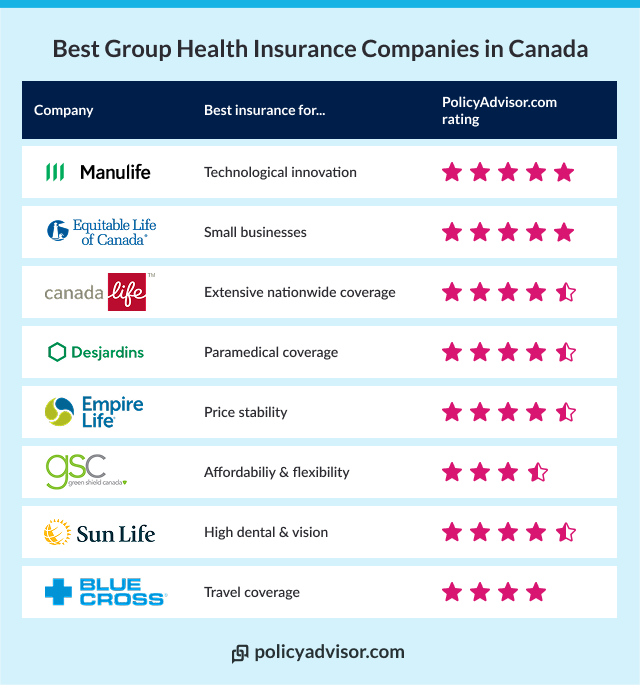
What are the best group insurance companies in Canada?
In Canada, companies such as Sun Life, Canada Life, Manulife, Desjardins, Green Shield, and more offer the best group health insurance rates in 2025:
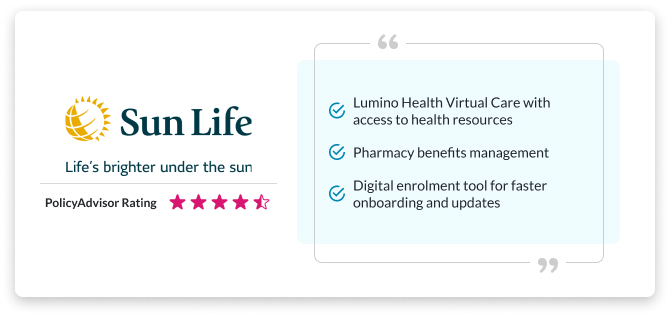
1. Sun Life
Overview: Sun Life Financial, one of Canada’s top group benefits providers Canada, offers a wide range of insurance, investment, and retirement, and group benefits solutions. Understanding the importance of workplace health, Sun Life offers a range of group health insurance products that include digital tools to manage employee onboarding, benefits, reports, billing statements, and more. The company offers all of this while balancing costs and is a great option if you’re looking for group health benefits for your organization.
PolicyAdvisor Rating: 4.5/5
What they offer:
- Extended Health Care (EHC), dental, and vision care
- Life and accidental death insurance
- Travel assistance
- Short-term and long-term disability
- Healthcare Spending Accounts (HSA)
- Mental health and wellness
- Paramedical expenses such as chiropractors, physiotherapists and other medical professionals
- Prescription drugs cost management
What we like:
- Digital enrolment and management tool that helps onboard members and allows efficient admin management
- The Lumino Health Virtual Care service that provides access to physical and mental health resources and specialists
- Pharmacy benefits management that helps save on medication costs
- Teladoc Medical Experts® Services for insureds diagnosed with a serious medical condition including consultation on treatment plans, locating specialists and customized guidance, support and advice
- Offers one of the highest coverage maximum for Dental and Vision
- Flexible plan design options to meet employee needs and fit companies budget
- My Sun Life Mobile app that lets employees submit their EHC claim and make payments within 24 to 48 hours
- Integrating diversity, equity and inclusion (DE&I) such as gender affirmation coverage
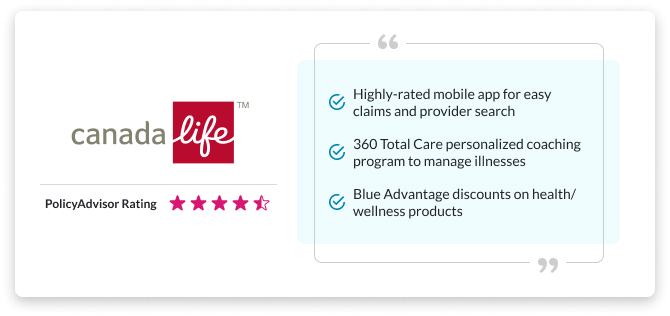
2. Canada Life
Overview: With over 170 years of experience, Canada Life is a name you can trust when it comes to group health insurance. They’ve been around the block and definitely know a thing or two about keeping businesses covered. With a range of options, including health, dental, life, and disability insurance, they’ve got your employees covered.
PolicyAdvisor Rating: 4.5/5
What they offer:
- Life, critical illness, and accidental death insurance
- Prescription drug cost management
- Short-term and long-term disability insurance
- Dental and vision care
- Paramedical services (such as massages and physiotherapy)
- Healthcare Spending Accounts (HSA)
- Emergency medical coverage and travel assistance
- Additional benefits for retirees or self-employed
What we like:
- Freedom at WorkTM that customizes solutions for small businesses
- They allow the possibility of a savings plan (RRSP, TFSA, DPSP)
- Expats or new to Canada insurance plans that help international employees get the health coverage they need
- Extensive network of healthcare providers nationwide
- Digital admin tools for online enrolment, management and billing
- DrugSolutions program helps you provide the care your employees need at a price you can afford

3. Manulife
Overview: Manulife Financial, a leading provider of financial services in Canada, offers comprehensive solutions for group benefits. With a strong commitment to supporting businesses and their employees, Manulife leverages over 130 years of experience to deliver innovative and flexible group health services.
PolicyAdvisor Rating: 4.5/5
What they offer:
- Life and Accidental death Insurance
- Short and long-term disability
- Extended Healthcare
- Dental & Vision
- Healthcare Spending Accounts (HSA)
- Coordination of benefits (COB)
- Mental health support
- Personalized medicine program
- Opioids and drug plan
What we like:
- One of the most technologically advanced with AI underwriting and innovative mobile app
- Manulife Mobile Enhancement facilitates employee health management with convenient access to group benefits via mobile technology
- The company offers a digital setup that is quick and efficient, with completion within 5-7 business days
- Trip cancellation insurance that is available as an optional add-on to Emergency Travel Assistance (ETA) plans
- Manulife offers a 28-month rate guarantee on all benefits, along with a standard 16-month rate guarantee for added stability
- The Employee Family Assistance Program (EFAP) is integrated with Mental Health Counseling Plus, providing comprehensive support for overall well-being
- Manulife Health by Design™ ensures that employees receive the right care, at the right time, and in the right way, enhancing health outcomes
- Manulife offers a Personalized Medicine Program to determine the right dosage and medication for plan members
- DrugWatch which is an oversight program to ensure value as drug costs rise
- My Drug Plan which offers centralized access to pharmacy-related resources and drug lookup tool
- Specialty Drug Care Program that manages specialty drugs to save costs and improve health outcomes
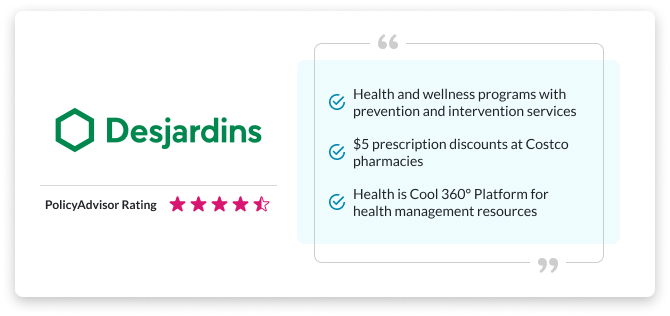
4. Desjardins
Overview: Desjardins Group, a leading cooperative financial institution in Canada, is renowned for its comprehensive financial services, including insurance and investment solutions. With a strong focus on member satisfaction and community support, Desjardins delivers innovative group health insurance offerings like the Manager Assistance Program, Health is Cool 360° Platform and more.
PolicyAdvisor Rating: 4.5/5
What they offer:
- Life, Accidental Death and, Critical Illness insurance
- Online app for claims and other services
- Health and wellness resources
- Travel insurance
- Employee assistance program
- Virtual healthcare
- Patient support program for specialty drugs
- Second medical opinion add on
What we like:
- Offers the highest paramedical coverage for health practitioners such as chiropractor, massages etc.
- Most of Desjardins’ group insurance plans include an employee health and wellness program, and can also include prevention and intervention services
- The Omni all-in-one mobile app that helps members submit claims and access information
- The Costco Preferred Pharmacy Network offers plan members a $5.00 discount per prescription if they have a co-insurance or per prescription deductible (Quebec is an exception)
- Drug cost saving by promoting biosimilars – savings of 15-50% for each targeted drug
- Out-of-country coverage that includes 180-day trips, a $5,000,000 lifetime maximum, optional trip cancellation, and 24/7 health assistance
- Gender affirmation that covers surgeries and treatments not covered by public health insurance and includes a workplace support kit
- The Health is Cool 360° Platform that offers resources to manage plan members’ health
- Health PACT that offers personalized phone coaching from a nurse to manage health issues and improve health
- Manager Assistance Program provides support for managers in resolving workplace issues and coaching, legal, financial, HR advice, and post-traumatic counseling
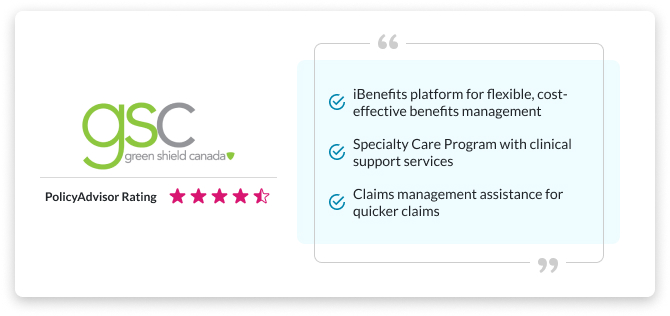
5. Green Shield Canada
Overview: Green Shield Canada (GSC) is a leading provider of health and dental insurance in Canada, renowned for its innovative approach to employee benefits. They offer employee benefits solutions like the iBenefits platform, specialty care program, claims management assistance, etc.
PolicyAdvisor Rating: 4.5/5
What they offer:
- Day-to-day, routine medical and dental expenses
- Emergency medical travel
- Travel insurance
- Fraud and abuse management solutions
- Contact center solutions
- Claims management assistance
- Formulary, claim cost, and utilization management
- Specialty pharmacy services via NKS Health
What we like:
- Flexible and affordable plans for health and dental only, without mandatory pooled benefit requirement
- All in one Honeybee Benefits app for quick claim assistance and benefit services
- All in one digital admin tool for easy enrolment and management
- Standardized plan options to select from
- Administration Services Only (ASO) allows you to control the cost of employee benefits — pay only for what your employees use
- Specialty pharmacy services offered by NKS Health
- Not-for-profit, reinvests in community health initiatives
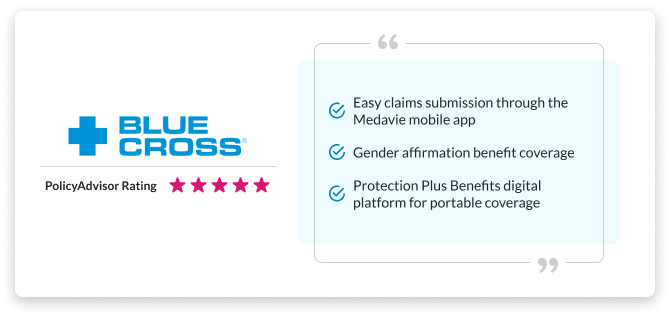
6. Medavie Blue Cross
Overview: Medavie Blue Cross is one of the top group benefits providers in Canada. As a not-for-profit organization, Medavie Blue Cross reinvests its profits to support community health initiatives and improve the lives of Canadians. They’re a reliable choice if you want to customize the group health benefits in your organization.
PolicyAdvisor Rating: 5/5
What they offer:
- Drug solutions
- Health Connected offers a Health Risk Assessment and a comprehensive Wellness Portal
- Connected Care platform offers innovative digital health resources
- Health and wellness programs
- Employee & Family Assistance offering health coaching and chronic disease management
- Second medical opinion
- Online doctors’ assistance
- Gender affirmation benefit
- Protection Plus Benefits (digital insurance platform)
- Disability, life and AD&D
What we like:
- Extensive nationwide coverage with a huge health provider network and broad accessibility
- High rate guarantee and renewal caps
- Blue Cross offers Medavie Mobile, one of the highest-rated apps in the industry with a 4.6-star rating on Google and over 8,000 reviews where plan members can easily submit claims, search for healthcare providers, and set reminders for medication refills
- Blue Cross also has the Protection Plus Benefits digital platform which includes portable critical illness, life, and AD&D coverage for all group members and their dependents. It offers group pricing and unique advantages with no additional cost or administration for the employer
- It offers one of the most comprehensive plans in the industry, specifically for travel insurance coverage up to 180 days (under age 75), $2 million per incidence ($5 million for Benefits for Small Businesses), $5,000 for trip cancellation, and $500 for baggage loss
- Second-opinion services that provide members and eligible dependents access to specialists at world-class medical institutions for a second opinion when diagnosed with a serious illness
- 360 Total Care is a personalized coaching program for managing diabetes, high blood pressure, high cholesterol, and obesity. Supported by digital health devices linked to the 360Care app for remote health monitoring
- Blue Advantage that allows members to save up to 20% on health and wellness services/products, including dental, medical supplies, vision care, and fitness
- Virtual medical care and Employee Assistance Program are included at no additional cost for Benefits for Small Business plans

7. Equitable Life of Canada
Overview: Equitable Life of Canada is a trusted name in the insurance industry, known for its comprehensive coverage and commitment to customer service. Equitable Life of Canada has solutions across requirements for health, dental, or travel insurance. So, you can choose a policy based on what your employees need most.
PolicyAdvisor Rating: 4.5/5
What they offer:
- Life, accident and critical illness
- Health and dental
- Healthcare spending accounts (HCSA)
- Taxable spending account (TSA)
- Disability management solutions
- Health, wellness and online services
- myFlex flexible benefits
- EZBenefits for small business
- Personal health and dental coverage
- Fraud detection and prevention
- Drug plan management
- Disability management
What we like:
- Equitable offers a well-differentiated range of plan design options (Bronze, Silver, Gold, and Platinum)
- The Online Plan Member Enrolment (OPME) tool streamlines the onboarding process for new benefits plans, benefiting both administrators and members. Available at no extra cost for Equitable group benefits plans, it sends personal emails with reminders and instructions to members, easing the workload for administrators
- Equitable EZClaim® that enables plan members to submit claims through a secure web portal or mobile app, leading to quicker claim payments
- Long-term pricing stability for health and dental benefits
- Minimum participation requirement is only 2 employees, hence, ideal for small businesses
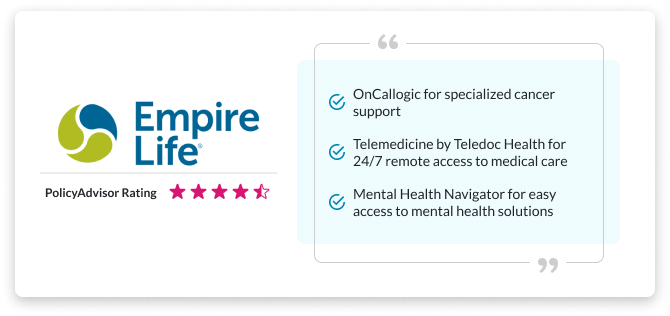
8. Empire Life
Empire Life is a reputed life insurance and group benefits provider, committed to supporting the financial security and well-being of Canadian employees and their families. Empire Life has flexible and comprehensive plans that cater to the diverse needs of businesses.
PolicyAdvisor Rating: 4.5/5
What they offer:
- Health and dental coverage
- Accidental death and dismemberment coverage (AD&D)
- Life insurance
- Critical illness insurance
- Mental health support
- Healthcare spending accounts
- Paramedical coverage
- Travel insurance
What we like:
- Offers long rate guarantees and renewal caps for long term price stability
- User-friendly mental health portal called Mental Health Navigator for easy access to solutions
- Telemedicine by Teledoc Health that provides 24/7 remote access to primary medical care and professionals
- Quick e-claims and provider-submitted claims which means that the money is back in an employee’s account within 24 hours
- Employee Assistance Program (AssistNow) that assists plan members
- OnCallogic that provides specialized cancer support
How does group health insurance work in Canada?
Group health plans are offered by employers and businesses in Canada, typically on a cost-sharing basis. These plans cover access to medical, dental, and other health-related services. This benefit supports employees’ well-being and enhances job satisfaction and loyalty, with additional tax benefits.and additional riders.
Here’s how group health insurance works in Canada:
- Employer-sponsored plan: Employers offer group insurance to eligible employees, often covering a significant portion of the premiums
- Cost sharing: Employees pay the remaining premiums through payroll deductions
- Broad coverage: Policies typically cover medical, dental, vision, and prescription drug expenses
- Eligibility requirements: Employees may need to work a minimum number of hours or complete a waiting period to qualify
- Tax benefits: Employer contributions are usually tax-deductible, making it a cost-effective benefit for businesses
- Flexibility: Some plans allow employees to customize their coverage with additional benefits
What types of group insurance plans are available in Canada?
In Canada, several types of group insurance plans are available to meet the needs of businesses and their employees. Some of the best plan include health insurance, dental insurance, vision insurance, disability insurance, critical illness insurance and more:
- Health insurance: Covers medical expenses like prescriptions, hospital stays, and specialist visits
- Dental insurance: Provides coverage for routine dental care, cleanings, and major procedures
- Vision insurance: Covers eye exams, glasses, and contact lenses
- Life insurance: Offers a death benefit to the employee’s beneficiaries
- Disability insurance: Provides income replacement during illness or injury
- Critical illness insurance: Pays a lump sum if diagnosed with a serious illness
- Employee Assistance Programs (EAPs): Support for mental health and wellness
What is the average cost of group benefits insurance per employee in Canada?
The average cost of a group health insurance plan in Canada ranges from $1,500 to $4,000 per employee per year. The actual cost depends on the types of benefits you include, such as extended health, dental, vision, and life insurance.
For small businesses, group insurance premiums typically equal about 15% of total payroll, while larger organizations may spend closer to 30% of payroll on their employee benefits plans.
Insurers calculate premiums by multiplying the level of coverage across each benefit type by the applicable rate. Choosing the right group insurance plan helps you manage costs while offering meaningful coverage to attract and retain top talent.
What is the minimum number of employees required to qualify for group insurance in Canada?
In Canada, most insurers require a minimum of three to five full-time employees to qualify for a group insurance plan. Some providers may allow you to start a plan with just two unrelated employees, as long as they meet the insurer’s minimum working hours, which is usually 20 to 30 hours per week.
To activate the plan, employers must include a majority of eligible employees, often at least 70% participation, to ensure balanced risk. Group health benefits rely on risk sharing across a pool of employees, which is why insurance companies set minimum group sizes.
Small businesses that don’t meet these requirements can consider a Health Spending Account (HSA) or an individual employee benefits plan until they grow.
Can I customize group benefits packages for different types of employees?
Yes, you can customize group benefits packages in Canada to meet the unique needs of different types of employees. Many employers design tiered employee benefits plans that offer varying levels of coverage based on job role, seniority, or employment status (e.g., full-time vs. part-time).
Insurers allow you to structure plans with different coverage for executives, managers, and general staff, while still maintaining compliance with group insurance rules. For example, executives may receive enhanced health, dental, and life insurance benefits, while entry-level employees may receive core health and drug coverage.
How to purchase a group benefits insurance plan?
To provide your employees with meaningful and cost-effective protection, you need to take a structured approach when purchasing a group benefits insurance plan in Canada. Follow these key steps to make an informed decision and set your team up with the right coverage:
- Identify your employees’ needs: Start by analyzing what types of benefits—like health, dental, vision, or mental wellness—your team values and requires the most
- Research and compare group insurance providers: Look into various group benefits insurance providers in Canada to understand the types of plans available and their flexibility
- Evaluate plans for coverage, cost, and value: Carefully compare premiums, deductibles, coverage limits, and additional features to find a plan that balances affordability with comprehensive protection
- Speak with a licensed insurance advisor: Connect with an expert (such as our licensed group insurance advisors at PolicyAdvisot) who can walk you through policy details, explain tax advantages, and ensure you stay compliant with regulatory requirements
- Choose the best-fit plan for your business: Select a plan that aligns with your company’s goals, budget, and the needs of your workforce
- Work with the provider to enroll your employees: Collaborate with the insurer to roll out the plan, guide your employees through the enrollment process, and ensure coverage starts without delays
Spoilt for choice? Let our experts help you decide!
Whether you’re looking for comprehensive coverage, competitive pricing, or top-notch service, there’s a provider out there that’s perfect for you. Finding the best group insurance company in Canada is all about finding the right fit for your team.
At PolicyAdvisor we work with 30+ of Canada’s best insurance companies. Our expert licensed advisors assist you with deciding the ideal group benefits provider for you. Our advisors will ask you simple questions about your business, employees, and the coverage amounts you’re seeking to find the best group coverage plan for you.
Frequently asked questions
Are group health insurance premiums tax-deductible for employers in Canada?
Yes, group insurance premiums are generally tax-deductible for employers in Canada. Premiums paid for employee health and dental benefits can typically be claimed as a business expense, reducing the employer’s taxable income. However, tax treatment may vary for other types of coverage, such as life or disability insurance.
To ensure compliance and maximize deductions, employers must consult a tax professional or review Canada Revenue Agency (CRA) guidelines. This makes group insurance a financially beneficial offering for small businesses.
Why should employers in Canada offer group benefits?
An employee benefits package helps cover costs for medical services not covered by provincial health care plans. It can also be combined with a retirement and savings plan to help employees achieve their financial and retirement goals. While group benefits seem to favor employees, they mutually benefit both parties.
Benefits for Employees:
- Attract and retain talented employees
- Obtain comprehensive coverage at affordable rates
- Access a wider range of benefits
- Lower costs compared to most private plans
- Protect the health and well-being of employees and their families
- Reduce financial stress during unexpected events
Benefits for Employers:
- Gain tax advantages
- Reduce administrative burdens
- Increase employee satisfaction and productivity
- Improve morale and enhance productivity
- Write off group benefit premiums as a business expense
- Maintain a competitive edge in the job market
- Attract and retain key employees
What factors should I consider when selecting the best group benefits provider in Canada?
When you’re picking a group insurance provider in Canada, here are a few key things to consider:
- Coverage that meets your employees’ needs: Think about what your team needs. Do they require extensive coverage or just the essentials? Make sure the provider offers plans that match your crew’s health needs.
- Price tag vs. quality: Balance affordability with quality service. You want a provider that won’t break the bank but still delivers top-notch care when your team needs it most.
- Network of providers: Check if the insurance provider has a wide network of doctors, specialists, and hospitals. Having plenty of options means your team can access care conveniently.
- Reliable customer service: Consider how the provider treats its customers. You’ll want one that’s easy to reach, helpful, and quick to resolve any issues your team might face.
- Flexibility for future needs: Think about the future. Does the provider offer flexibility to adapt as your team grows or if your needs change? You’ll want a partner who can keep up with your evolving demands.
Several employees in my organization take regular vitamins and supplements. Will any of these companies cover these?
Supplements are not eligible for benefits under most group health plans. However, some group policies may cover prescription supplements.
What factors should I consider when selecting a group insurance provider in Canada?
Think about what matters most to your team. Do you need comprehensive coverage or just the basics? Are you looking for affordability or top-notch service? Keep these factors in mind when comparing providers to find the perfect match.
Can you recommend reputable group insurance companies in Canada with a specific focus on health?
Absolutely! Sun Life Financial Corporation, Canada Life Assurance Company, Manulife Financial Corporation, Desjardins Insurance, and Green Shield Canada are all great options known for their quality service and comprehensive coverage options.
As an employer in Canada, am I required to offer group benefits to my employees?
No, employers in Canada are not legally required to offer group benefits to their employees. However, providing group benefits can be a valuable tool for attracting and retaining talent, as well as enhancing overall employee satisfaction and well-being.
How many employees does a company need to qualify for group benefits insurance?
Typically, a company needs at least 3 employees to qualify for group benefits insurance. The exact number can vary depending on the insurance provider and the specific plan requirements.
Can I offer benefits to part-time employees?
Yes, many employers choose to offer benefits to part-time employees. While not all plans may cover part-time workers, some insurance providers offer flexible options that allow coverage for part-time staff, helping to attract and retain a diverse workforce.


 1-888-601-9980
1-888-601-9980

